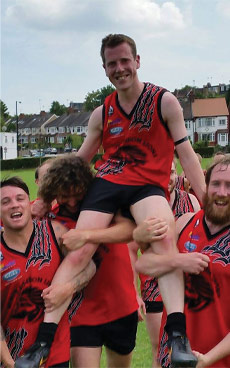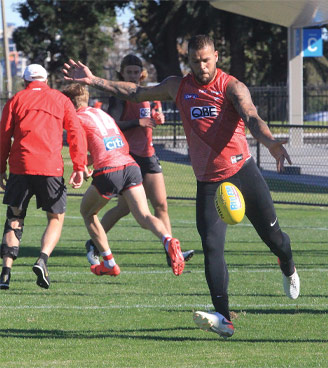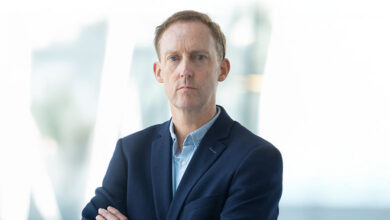Jonathan Drennan: Promoting Australia’s indigenous game

Conspicuously, over recent decades, Aussie rules football has lured its fair share of Ireland’s GAA talent ‘down under’. However, ‘the Irish experiment’ is no longer confined to the paddock. Ciarán Galway meets with east Belfast-born Australian Football League (AFL) State Media Manager Jonathan Drennan in Sydney’s Moore Park to discuss his role in promoting Australia’s indigenous game.
From Kerry’s Tadhg Kennelly to Down’s Marty Clarke, and from Mayo legend Cora Staunton to Tipp’s Colin O’Riordan, the AFL is no stranger to aspiring Irish sportsmen and women, eagerly pursuing a professional career in ‘the lucky country’. Simultaneously, however, and relatively speaking, Belfast native Jonathan Drennan has found himself flying below the radar, immersed in the promotion of Aussie rules across New South Wales (NSW) and the Australian Capital Territory (ACT).
Drennan’s earliest ambition was a career in journalism. Having graduated from Trinity with a degree in English literature followed by a Master’s in journalism from DCU, he secured an unpaid internship with the Irish News in Belfast. However, like many of his generation, he fell victim to the economic turmoil which ravaged communities in the late 2000s.

“It was only a three-month unpaid internship, but I absolutely loved it. It was a really interesting experience as well because being from east Belfast, I never would have bought the Irish News. I had grown up in a parallel community.
“But 2009 was a really tough time in both Ireland and the UK. I was working on a shift-by-shift basis and it became a hand-to-mouth existence. I was 23, living at home and I felt really panicked,” Drennan recalls.
As such, he assessed his options before taking a leap into advertising. “All I wanted to do was to be a journalist,” he says, “but I didn’t really feel like the opportunities were there.”
Although he embarked upon a graduate scheme in London, Drennan continued to pursue his love of writing, working by night to produce content for both the Irish Times and the Guardian. Meanwhile, he began to climb the ranks in advertising. “I suppose that advertising was my day job, but my passion was always journalism,” he muses.
By November 2014, Drennan had reached the end of his time in London and the scene was set for his emigration. “London is incredibly exciting but it’s a very tough city if you’re not a millionaire. I don’t regret it for one minute and I would advise any young person to go out and have their time there, but after five years, I was exhausted both mentally and physically and I really needed a change,” he explains.
Emigration
While under no illusion that his life would suddenly fall into place upon arrival in Australia, Drennan did underestimate the potential loneliness of travelling solo across the world in an attempt to re-establish himself. “Many people come to Australia thinking that it’s some sort of panacea, but it’s not,” he asserts, reflecting on his own initial naïveté.

“The first weeks can be really tough. I certainly found that. The fact that it may have been a beautiful sunny day outside almost made things harder. It claws at you because you’re very far from home and you attempt to put up a positive façade for your family.
“I was 28, male, single, jobless and Northern Irish, so even finding accommodation was a challenge – people had a perception that I was intent on partying. Eventually, I moved in with some Colombians and from there the ball got rolling. I got a job – which wasn’t what I would have wanted but it gave me a salary – and then made some friends,” he explains.
Irish network
While expressing a pride in being from Northern Ireland, Drennan initially took a personal decision to avoid formally engaging with the sizeable Irish community in Sydney.
“You can see, for instance in Coogee and Bondi, that there are some prominent Irish enclaves and there is a really strong culture of Gaelic games. There’s nothing wrong with that. However, I made deliberate decision to avoid tapping into it. Not for any other reason other than I was moving to Australia and I wanted to integrate into Australian society. That’s why I made the decision to play Australian football. It was a long and possibly lonelier road, but it was beneficial,” he explains.
Now well established in Sydney, Drennan acknowledges his delight in meeting people from ‘home’. “In fact, I was invited to attend the Irish Consulate on behalf of the AFL which was a real eye-opener for me because I haven’t had a formalised link with the Irish community here.
“I brought my French wife Christina along and she was amazed by how friendly an experience it was, which made me very proud. It was only an evening event, but we really do have a huge asset as Irish people in terms of our social ease. I miss that.”
Aussie rules
Drennan’s route to becoming “the only person within the AFL with an Irish accent” had its origins in London. “I played rugby in the winter and during the off-season, an Australian colleague suggested that I try out Australian football with him. A bit like Gaelic games in Sydney, there’s quite a vibrant league there among Australian expats. I ended up playing for the North London Lions and made many friends there, which had a huge impact on me.
“When I moved to Sydney, I played for the North Shore Bombers and then Sydney University, although not with a huge amount of success. Again, it had a real effect on me socially — sport has the power to do that.”

With his interest in Aussie rules beginning to peak, Drennan and his then girlfriend (now wife) Christina began attending Sydney Swans’ games together at the Sydney Cricket Ground. An experience at one game in particular would have a significant impact on his career trajectory.
“It was the last regular game of the season. There was a young boy sitting in front of us who was blind and his best friend was sitting alongside, commentating on the match for him. The experience inspired me to write a piece for The Guardian, through which I then developed a relationship with the head of media for the Swans who informed me that the head of media role with the AFL had become available.
“At that time, I was working as a copywriter within advertising and a head of media role seemed too far beyond my remit. I went for it anyway and now I’ve been in the job for a year,” he unassumingly recounts.
Indigenous
Describing the inimitable characteristics of Australian Football, Drennan submits: “To the uninitiated, it can feel fairly chaotic, but it’s an amazing game with an amazing history.
“Aussie rules is unique in that it’s Australia’s indigenous game. It has its origins in a game played by Aboriginal people called ‘marngrook’ and from there, it was developed by Tom Wills from western Sydney with the intention of keeping cricketers fit during the winter – hence why it’s played on an oval playing field with teams of 18 people.”
Today, around 10 per cent of the AFL’s playing cohort identify as either Aboriginal or Torres Strait Islander. This is recognised with an annual ‘Indigenous Round’ which aims to celebrate indigenous players and culture. All 18 AFL clubs don special indigenous-themed guernseys and the climax of the occasion is ‘Dreamtime at the G’, an annual match between Essendon and Richmond at the 100,024-seater Melbourne Cricket Ground (MCG).
However, there is also a significant international flavour to the sport. “Some of the greatest names in the game are from international backgrounds, including Austria’s Alex Jesaulenko,” Drennan stresses. “It’s Australia’s game, but also very much driven by a diverse range of backgrounds.”
In particular, he emphasises the Irish influence. “Certainly, since the 1980s, with Roscommon’s Paul Earley and Dublin’s Jim Stynes, Irish people have had a huge impact on the sport,” he describes. In fact, as of 2019, there are now more Irishmen on AFL lists in 2019 than there are Tasmanians, with counties Cork, Derry, Dublin, Kerry, Kilkenny, Laois, Mayo, Meath, Sligo, Tipperary and Tyrone all represented.
“There are 14 Irish men on the AFL lists and five Irish women on the AFLW lists right now. This influx has gained a degree of momentum, particularly since the success of Cora Staunton – one of the greatest female athletes to emerge from Ireland – who plays for the Greater Western Sydney Giants.”
However, while Drennan identifies a parallel between Gaelic football and Australian football in terms of heritage, there is a crucial difference. While the GAA, right up to its elite playing level remains amateur, AFL players are paid and sometimes significantly so. This represents an alluring prospect for young GAA stars who compete in front of AFL scouts at annual trials in Dublin.
Challenger brand
In Australia, the states of Victoria (Melbourne), Western Australia (Perth) and South Australia (Adelaide), alongside the Northern Territory are defined as traditional Aussie rules heartlands. As is the case in Queensland, the AFL remains a challenger brand in Sydney and across NSW more generally.
This requires the AFL to be innovative with its media in order to cut through the noise made by competitors, especially the ever-popular National Rugby League (NRL). Portraying Sydney as a “very different market” when compared with a city like Melbourne, Drennan indicates that he enjoys the subsequent challenge.
Describing his role as media head, he stresses that the peculiarities of Sydney require a more proactive approach to media relations, including actively pitching angles to journalists. “Having said that, it’s improving all the time and we have very positive relationships with the media. It helps that we have one of the game’s most famous players ever – Lance ‘Buddy’ Franklin – playing in Sydney. That trickles down and has a huge impact on young Sydney kids.
“Therefore, while it might not have been the case several years ago, it’s now commonplace to see young people sporting Sydney Swans jerseys and likewise, in western Sydney – which is a heartland of rugby league – kids wearing the GWS Giants guernseys.”
Attendance
In NSW, Drennan discerns the NRL as being the AFL’s major competitor. “The biggest sport here, alongside cricket, is rugby league and there are nine clubs in Sydney. Likewise, while Sydney is a city that likes its sport but it also needs its clubs to do well. Sydney likes a winning team,” Drennan outlines.
Given this dual challenge, it can be difficult for Sydney’s AFL clubs to attract the same level of attendances as they might achieve elsewhere, especially in the absence of consistently positive performances.
Nevertheless, Drennan is keen to emphasise the AFL’s success in consolidating its foothold in Sydney. “Our growth is absolutely phenomenal, particularly in terms of female participation since the inception of AFLW in 2017,” he indicates.
Indeed, contextualising average attendances of 40,000 for the Swans and 16,000 for the Giants, the AFL media head insists that it is important to remember that the Sydney Swans only relocated from south Melbourne in the 1980s. Similarly, the GWS Giants only debuted as the 18th AFL team in 2012.
“In GWS, it’s been good to have a relatively new club that is competitive – Giants fans love getting one over the Swans and vice versa. The great thing is that there is now a genuine rivalry in Sydney.”
Accessibility
While concerned with securing the best media coverage possible for both the GWS Giants and the Sydney Swans, Drennan also acknowledges the fundamental importance of the game’s grassroots. “I want to ensure that every single person who wants to play Australian football can do so. If someone feels that they can’t play, then we need to consider what we can do to make access possible.
“I’m quite relentless in terms of the demands that I put on myself and my real ambition is to play a key role in building awareness for this amazing game. My focus is on the growth of the female game and I would love every girl in NSW and ACT to feel that they have the opportunity to play Australian football. We are inclusive as a game and I want to spread that message beyond any supposed boundaries, whether they be gender, disability, sexuality or ethnicity.”
Through his writing, Drennan regards himself as a purveyor of the “lesser known story” and this is a strength that he continues to apply in his current profession. “While interesting to a point, I’ve never really been captivated by marquee players talking about how many goals they’ve scored,” he maintains.
Rather, a highlight for the AFL official in 2018 was the story of Cathleen Ross, a profoundly deaf girl and junior player with the East Gosford-based Terrigal Avoca Panthers. “Cathleen’s mother had approached a number of sporting codes seeking a place for her daughter to participate. While the others told her it would be too difficult to accommodate her daughter, the local AFL club were keen to have her.
“Cathleen began playing for the under-14s and, after her team won their way to a grand final, footage emerged of her teammates surrounding her and singing the team song – as is customary after a win – as she signed the words.
“That encapsulated what the AFL is about. The effect that sport can have on a young person is much more significant than winning or losing, it’s about feeling that you can belong,” he proclaims proudly.

Reflection
Of course, Drennan’s path of expatriation and borderline despair, followed by opportunity and triumph is one well worn by thousands of Irish émigrés in Australia and beyond.
Consequently, while looking to the future in terms of his AFL role, he also recognises a need to pause and reflect upon his own personal journey. “Sometimes, I have to step back, think about the lonely immigrant that arrived here four years ago who wasn’t sure he would even be able to secure a job and realise that I’ve actually done okay.
“Right now, I’m surrounded by an incredibly passionate team and it’s a real privilege to work for the AFL. As a person from an Irish background, I feel proud to be here,” he concludes with characteristic modesty.





